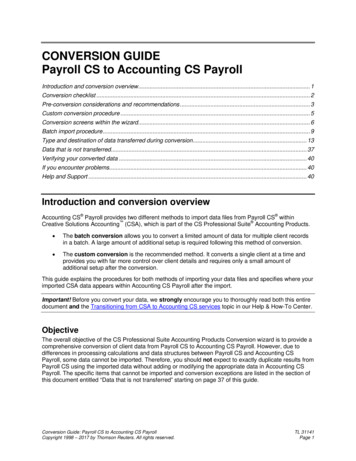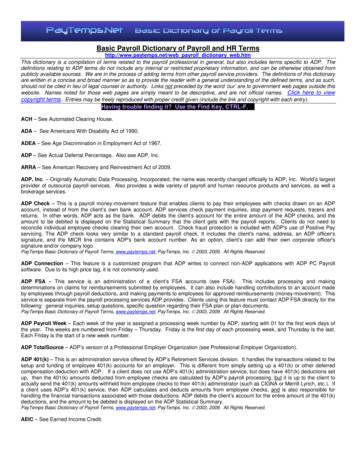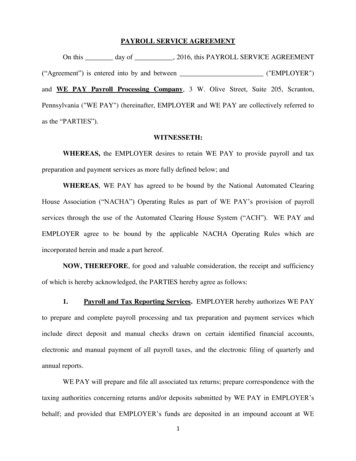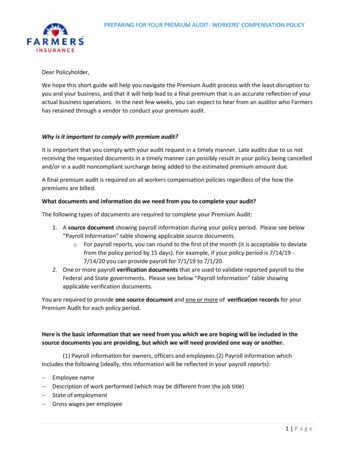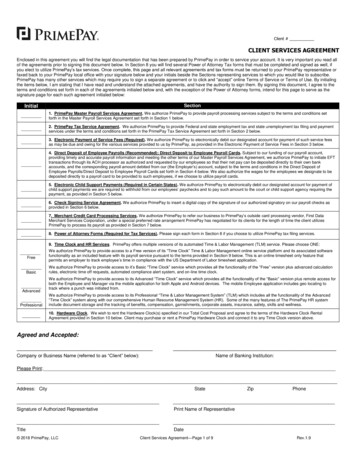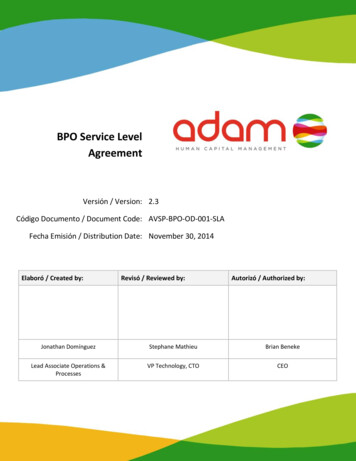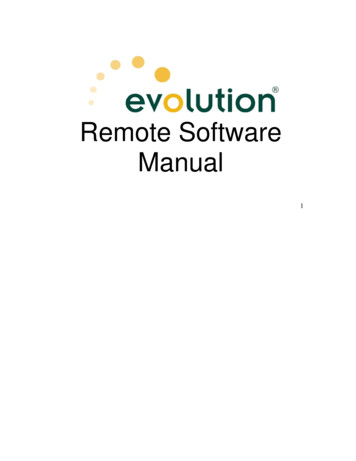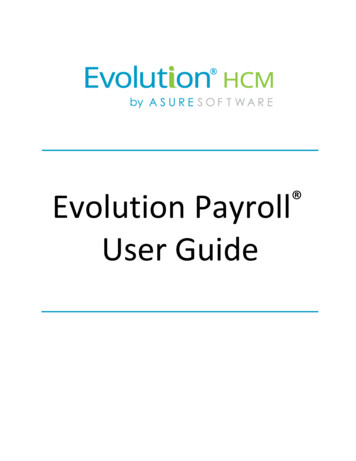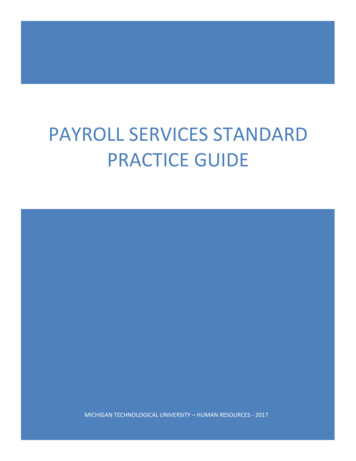
Transcription
PAYROLL SERVICES STANDARDPRACTICE GUIDEMICHIGAN TECHNOLOGICAL UNIVERSITY – HUMAN RESOURCES - 2017
PAYROLL SERVICES STANDARD PRACTICE GUIDETable of ContentsObjective. 2Overview of Payroll Procedures . 2Department Roles and Segregation of Duties for Payroll Processing . 2Payroll Guidelines. 2Payroll Processing. 3Payroll Time Entry – Individual Time Sheets . 3Payroll Time Entry - Organizational Time Sheets . 4Department Time Entry. 4Web Time Entry . 5TimeClock Plus Entry . 5Reporting Prior Pay Periods . 6Revising Prior Pay Periods. 6Verifying and Monitoring Payroll Transactions. 6Record Retention. 7Endnotes . 7Page 1 of 7
PAYROLL SERVICES STANDARD PRACTICE GUIDEObjectiveThis guide outlines standard payroll procedures and internal controls that should be applied by allUniversity departments for paying employees.Overview of Payroll ProceduresDepartments are responsible for maintaining effective systems of monitoring the accuracy of its payrollexpenses, the largest expense to the University. Each step needs to be evaluated for proper controlsbased on the reporting method that is used by the department. The reporting methods are payrolltime entry, department time entry, and web time entry.Department Roles and Segregation of Duties for Payroll ProcessingRegardless of the reporting method, the department is responsible for maintaining internal controls forthe payroll process. Segregation of duties needs to be established to ensure one individual is notrecording, approving and reviewing the payroll. The following are the primary roles that need to bemaintained to establish strong internal controls.1. Timekeeper: Responsible for ensuring that time and attendance is submitted by the reportingdeadline. The employee acts as the timekeeper in the case of web time entry2. Approver: Responsible for ensuring that time and attendance is approved and submitted by thereporting deadline.3. Proxy: Authorized designee for the approver in the approver’s absence.4. Department Administrator: Departmental designee who is responsible for certifying that theprocess for gathering and maintaining the data needed, along with completing and reviewing thepayroll report, has followed the University’s recommended guidelines.5. Financial Manager/Budget Unit Administrator: Responsible for monitoring the accuracy of thepayroll by verifying the labor distribution reports.Payroll GuidelinesAll time must be approved prior to being submitted to Payroll Services for processing. The approverneeds to have knowledge that the hours reported by the employee are accurate. Time and attendanceis reported based upon the Fair Labor Standards Act (FLSA) i classification of the employee.1. Non-Exempt (Overtime Eligible): Non-exempt employees do not meet the exemption standards ofthe FLSA. All hours need to be reported on a daily basis for each non-exempt staff member usingthe appropriate earn codes.2. Exempt: Exempt employees meet the exemption standards of the FLSA. Exempt employees reporttheir exception time, not hours worked ii. Absences from normal work schedules are to be reportedin half day increments only. Half-day increments are converted to hours for time reportingpurposes only. Absence of a majority of a day (based on the employees work schedule) isPage 2 of 7
PAYROLL SERVICES STANDARD PRACTICE GUIDEconsidered a half-day absence for reporting purposes. Actual hours absent are not to beconsolidated for reporting at a later date.Recommended Conversion TableFTEWorkday *Hours AbsentHours Reported1.001.001.008 hours8 hours8 hoursLess than 4 hours4 hours or moreAll day0 hours4 hours8 hours0.750.750.756 hours6 hours6 hoursLess than 3 hours3 hours or moreAll day0 hours3 hours6 hours* 40 hours multiplied by the employee’s full time equivalent (FTE) divided by 5 days(standard work week) equals the number of hours to be used as a standard workday.Payroll ProcessingPayroll Time Entry – Individual (Paper) Time SheetsCollecting Time and AttendanceEmployees submit their daily hours worked and exception time used during the pay period.Approving Time and Attendance1. The employee and supervisor (or proxy) sign off on the time reporting document.2. The supervisor (or proxy) delivers the time to the department timekeeper. Employeesshould not deliver their approved time to the timekeeper.Submitting Time and Attendance1. If an internal time reporting document is used by the department, the time must betranscribed from the internal time reporting document to the pre-printed time sheetdistributed by Payroll Services prior to submitting for processing.2. The certification page needs to be signed by the timekeeper and department administrator(or proxy). Submit the paper time sheets and signed certification page(s) to Payroll Servicesfor processing in a timely manner iii.3. The department must retain all internal reporting documents and time sheets. Please referto the Record Retention section of this document.Page 3 of 7
PAYROLL SERVICES STANDARD PRACTICE GUIDEPayroll Time Entry - Organizational Time Sheets (Rosters)Collecting Time and AttendanceFaculty and stipend employees and additional compensation are included on the organizationaltime sheets. Primarily, these employees do not have any exception time to report. Only submitexception time used, not hours workedii.Approving Time and Attendance1. The employee and supervisor (or proxy) sign the time reporting document.2. The supervisor (or proxy) delivers the time to the department timekeeper. Employeesshould not deliver their approved time to the timekeeper.Submitting Time and Attendance1. If an internal time reporting document is used by the department, the time must betranscribed from the internal time reporting document to the pre-printed organizationaltime sheet distributed by Payroll Services prior to submitting for processing.2. The certification page needs to be signed by the timekeeper and department administrator(or proxy). Submit the organizational time sheet and signed certification page(s) to PayrollServices for processing in a timely manneriii.3. The department must retain all internal reporting documents and time sheets. Please referto the Record Retention section of this document.Department Time EntryCollecting Time and Attendance1. Non-exempt employees submit their daily hours worked and exception time used duringthe pay period.2. Exempt employees submit exception time used only, not hours workedii.Approving Time and Attendance (2 options)1. Time approved prior to data entryA. The employee and supervisor (or proxy) sign the time reporting document.B. The supervisor (or proxy) delivers the time to the department timekeeper. Employeesshould not deliver their approved time to the timekeeper.2. Time approved after data entryA. The employee signs the time reporting document and submits to the departmenttimekeeper.B. The supervisor (or proxy) approves the time reported electronically on BANWEB afterdata is entered directly into Banner by the department timekeeper.Page 4 of 7
PAYROLL SERVICES STANDARD PRACTICE GUIDESubmitting Time and Attendance1. Time is entered by the department timekeeper directly into the Banner system(PHATIME) iv. The department timekeeper is responsible for entering all time reportingdocuments in a timely manneriii.2. The department must retain all internal reporting documents and time sheets. Please referto the Record Retention section of this document.Web Time EntryCollecting Time and Attendance1. Non-exempt employees submit their daily hours worked and exception time used duringthe pay period directly onto the electronic time sheet via BANWEB v.2. Exempt employees submit exception time used only, not hours workedii, directly onto theelectronic time sheet via BANWEB.Submitting Time and AttendanceEmployee submits time and attendance when finished entering their electronic time sheet viaBANWEB. The employee is responsible for submitting their time sheet in a timely manneriii.This time sheet is then routed electronically to the approver.Approving time and attendanceApprover (or proxy) will approve time via BANWEB. The approver (or proxy) is responsible forapproving time sheets in a timely manneriii.TimeClock Plus EntryCollecting Time and Attendance1. Non-exempt employees submit their daily hours worked by clocking in and out of TimeClockPlus for each shift. Exception time used during the pay period is entered directly intoTimeClock Plus by the employee’s supervisor or through the application’s Request Managerfeature.Approving time and attendanceApprover (or proxy) will approve time via TimeClock Plus. If an approver enters an employee’sshift manually, a proxy must approve the manually entered shift via TimeClock Plus. Theapprover (or proxy) is responsible for approving time in a timely manneriii.Page 5 of 7
PAYROLL SERVICES STANDARD PRACTICE GUIDEReporting Prior Pay PeriodsRegardless of the payroll processing method, submissions of previous pay periods will be donevia the fillable time sheet located on the Payroll Services website vi. To complete the time sheet,follow these guidelines:1. Employees submit their daily hours worked and exception time used during the pay period.2. The employee and supervisor (or proxy) signs the completed time sheet.3. The timekeeper, approver, or proxy will deliver the completed form to Payroll Services.Employees should not deliver their approved time to Payroll Services.4. The department must retain all internal reporting documents and time sheets. Please referto the Record Retention section of this document.Revising Prior Pay PeriodsRegardless of the payroll processing method, revisions of previous pay periods will be doneeither by completing the fillable manual time sheet located on the Payroll Services websitevii orby revising a copy of the original paper time sheet or web time sheet submitted to PayrollServices, ensuring all fields are legible. To complete the time sheet, follow these guidelines:1. Employees submit their daily hours worked and exception time used during the pay period.2. The employee and supervisor (or proxy) sign the completed time sheet. For copies of theoriginal or web time entry time sheet, write REVISED across the top of the time sheet. Checkthe box next to Revised at the top of the fillable manual time sheet.3. The timekeeper, approver, or proxy will deliver the completed form to Payroll Services.Employees should not deliver their approved time to Payroll Services.4. The department must retain all internal reporting documents and time sheets. Please referto the Record Retention section of this document.Verifying and Monitoring Payroll TransactionsDepartments are responsible for verifying that payroll transactions are accurate. Departments shouldverify the accuracy of the payroll reports by comparing the payroll transactions to the employee’scurrent position information. All additional pay, summer salary, bonuses, etc. should be verifiedagainst the department’s records. Any unauthorized or inaccurate transactions are to be investigatedand resolved immediately. Verifying tools include:1. HYOPAYG002B – Employee List: report is distributed to each time sheet organization onWednesday afternoon of off payroll week. Title, annual salary/hourly rate, index distribution, andadditional compensation are a few of the items available for verification.2. HYOPAYE001 – Gross Earnings: report can be run in Banner (GZAORPT) biweekly after payroll iscomplete. Earn codes used per employee, account code(s) charged, total hours charged, and grossamount charged are a few of the items available for verification.Page 6 of 7
PAYROLL SERVICES STANDARD PRACTICE GUIDE3. HYOEMP004 – Leave Balance Report: report is sent after each pay period is complete. This reportshould be used to verify exception hours available.Record RetentionRecord retention per
the payroll process. Segregation of duties needs to be established to ensure one individual is not recording, approving and reviewing the payroll. The following are the primary roles that need to be maintained to establish strong internal controls. 1. Timekeeper: Responsible for ensuring that time and attendance is submitted by the reporting deadline. The employee acts as the timekeeper in the .

